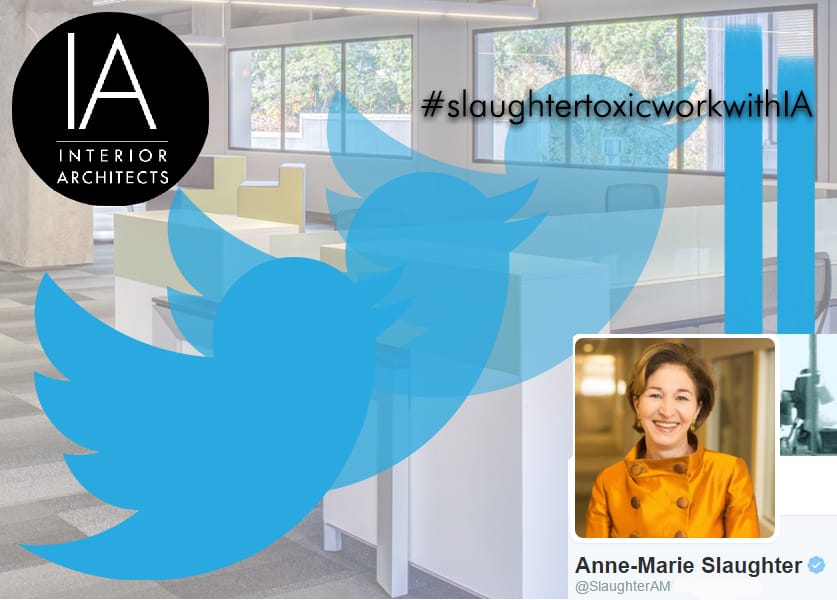IA took to Twitter to discuss work, cultural values, and corporate culture with the thought leader challenging the American workplace and its support of caregivers.

If you haven’t read A Toxic Work World, written by Anne-Marie Slaughter and published by the New York Times, you’ve probably read one of many responses to her position in the Washington Post, Refinery 29, Salon.com, or The Atlantic. In her article, Slaughter argues that part of the challenge facing the American workplace is an increasing competitiveness that is edging out not only traditional caregivers—namely women—but anyone who isn’t “healthy, and wealthy enough not to have to care for family members.” Her argument, which she develops further in her new book Unfinished Business, spans cultural values around gender equity, politics, and global economics.
IA asked Slaughter a few questions of our own; about ways we, as designers of the workplace, can help create a supportive and successful environment.
.@IAarchitects We still think of work as a “place you go” rather than a “thing you do.” #SlaughterToxicWorkwithIA
— Anne-Marie Slaughter (@SlaughterAM) December 22, 2015
We insist work be done on rigid schedules, even when many asking do so from a plane or in another city. #SlaughterToxicWorkwithIA
— Anne-Marie Slaughter (@SlaughterAM) December 22, 2015
Q2 What are questions you recommend we ask our clients during the discovery process to address a healthy balance? #SlaughterToxicWorkwithIA
— Interior Architects (@IAarchitects) December 22, 2015
I’m tempted to suggest you ask your clients whether it matters to them to have productive, creative workers! #SlaughterToxicWorkwithIA
— Anne-Marie Slaughter (@SlaughterAM) December 22, 2015
Precisely, how do they think we should prioritize work: Do we cancel plans/miss families to get the job done? #SlaughterToxicWorkwithIA
— Anne-Marie Slaughter (@SlaughterAM) December 22, 2015
Or,do we work in a timely manner that still allows people to have other important activities in their lives? #SlaughterToxicWorkwithIA
— Anne-Marie Slaughter (@SlaughterAM) December 22, 2015
Employees who sleep well and work with minimal stress perform better than exhausted, stressed-out, employees. #SlaughterToxicWorkwithIA
— Anne-Marie Slaughter (@SlaughterAM) December 22, 2015
This doesn’t include self-imposed stress; I’m an admitted adrenaline junkie in terms of external deadlines! #SlaughterToxicWorkwithIA
— Anne-Marie Slaughter (@SlaughterAM) December 22, 2015
Also ask if they are aware of the importance of diverse groups of thinkers + benefits of multiple perspectives. #SlaughterToxicWorkwithIA
— Anne-Marie Slaughter (@SlaughterAM) December 22, 2015
Q3 What are some examples of nations or cultures that have a healthy work culture?
— Interior Architects (@IAarchitects) December 22, 2015
All Nordic countries. They devised a combination of competition and care that sustains a competitive economy. #SlaughterToxicWorkwithIA
— Anne-Marie Slaughter (@SlaughterAM) December 22, 2015
Competitive Nordic economies support innovation, creative destruction, and investing in the next generation #SlaughterToxicWorkwithIA
— Anne-Marie Slaughter (@SlaughterAM) December 22, 2015
Taking care of those who took care of us is vital national work. No country is perfect but Nordic nations lead. #SlaughterToxicWorkwithIA
— Anne-Marie Slaughter (@SlaughterAM) December 22, 2015
Q4 How can we emulate some of those successful attributes through the design of the physical environment? #SlaughterToxicWorkwithIA
— Interior Architects (@IAarchitects) December 22, 2015
Beautiful spaces can promote creativity: Equally important are spaces for quiet time as well as collaboration. #SlaughterToxicWorkwithIA
— Anne-Marie Slaughter (@SlaughterAM) December 22, 2015
At a time when futurists worry robots will displace workers permanently, we should think about job shares #SlaughterToxicWorkwithIA
— Anne-Marie Slaughter (@SlaughterAM) December 22, 2015
Creating beauty encourages us to look up from our work, engage our senses, and feel like more than machines. #SlaughterToxicWorkwithIA
— Anne-Marie Slaughter (@SlaughterAM) December 22, 2015
Convivial spaces invite people to sit together, linger over coffee rather than eating at a desk or cubicle. #SlaughterToxicWorkwithIA
— Anne-Marie Slaughter (@SlaughterAM) December 22, 2015
Q5 How is work/life balance perceived for professionals who are not caregivers, but still want a 40 hour week? #SlaughterToxicWorkwithIA
— Interior Architects (@IAarchitects) December 22, 2015
This is an important question! 70+ hrs can be ok in crunch periods; it can be exhilarating but burn-out looms. #SlaughterToxicWorkwithIA
— Anne-Marie Slaughter (@SlaughterAM) December 22, 2015
In Unfinished Business I talk about careers as “interval training”- also how athletes get into peak condition.#SlaughterToxicWorkwithIA
— Anne-Marie Slaughter (@SlaughterAM) December 22, 2015
It is fine to have periods where you put work ahead of most things and periods of a more manageable pace. #SlaughterToxicWorkwithIA
— Anne-Marie Slaughter (@SlaughterAM) December 22, 2015
Looking back I think I would have been more productive in my 20s and 30s if I’d gotten more sleep and exercise. #SlaughterToxicWorkwithIA
— Anne-Marie Slaughter (@SlaughterAM) December 22, 2015
Q6 Do professionals with families have more lenience? Should single professionals be eager to work longer hours? #SlaughterToxicWorkwithIA
— Interior Architects (@IAarchitects) December 22, 2015
I don’t think slower intervals should only be for parents or caregivers. What about time to write, paint, play? #SlaughterToxicWorkwithIA
— Anne-Marie Slaughter (@SlaughterAM) December 22, 2015
Take up a new sport or activity you have always wanted to pursue. Live life more fully, however you define it! #SlaughterToxicWorkwithIA
— Anne-Marie Slaughter (@SlaughterAM) December 22, 2015
Read more of Slaughter’s thoughts on the workplace in The Atlantic.
